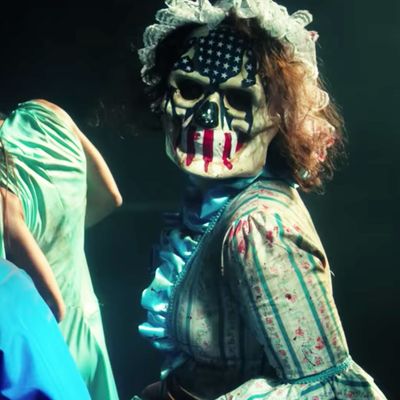
Five years ago, writer and director James DeMonaco brought forth his uncomfortably more-prescient-by-the-day Purge franchise, a movie universe in which the United States is ruled by a regime calling itself the New Founding Fathers of America. The NFFA dreamed up the annual Purge, an event where citizens can exorcise all of their rage in one 12-hour span by having free rein to rape, kill, loot, and destroy as much as they can over the course of a single night — and where the Haves can prey upon the Have Nots with impunity.
This July 4, we’ll go back in time for The First Purge, a prequel written by DeMonaco, but directed this time by Gerard McMurray. The story moves to New York, where Staten Island residents will “participate” in the experimental first-ever Purge staged by the U.S. government. (Participate being a loose term, since people trying to sit it out are forced to join the killing spree by violent militias!) But before we head to the island, let’s do a Purge 101 refresher course: What do we know about the New Founding Fathers? Who have the major players been up to this point? And how has the story changed from the first movie in which our heroes were a family of rich white people living in the Southern California suburbs? Let’s get our not-too-distant-seeming dystopia on.
The Purge (2013)
As the intro to the first Purge tells us, the year is 2022. Unemployment is below one percent. Crime is almost nonexistent, and U.S. has been pulled back from the brink of collapse — a full stock market crash, skyrocketing crime and unemployment are mentioned in newscasts — by a group called the New Founding Fathers of America, who rose to power eight years before (making it 2014 in Purge time), and whose governing doctrine exists as a kind of new religion, complete with a prayer. The NFFA implemented the Purge as a means of basically concentrating crime and mayhem into one single night (even called a “holiday”) in which all crime is legal and all emergency services are suspended for 12 hours, beginning annually at 7 p.m. on March 21.
The movie opens on the night of the fifth annual Purge, and from the start, we hear talk-radio callers sharing their thoughts on the real truth of the event. It’s a mechanism for population control, they say, where the poor, the sick, and the disadvantaged are weeded out for the benefit of the wealthy and the powerful so the government no longer has to shell out as much for assistance programs like welfare or health insurance. The wealthy barricade themselves in or purchase extravagant weapons to kill people with. Government officials designated as “level 10” are fully protected from harm, and everyone else is up for grabs.
The story focuses on the Sandin family, who are among the rich, white, protected one percent. The breadwinning father (Ethan Hawke) makes buckets of money working for a home-security firm that sells a mediocre product for way too much money. All is going well on Purge night until a bloodied black man (Edwin Hodge) on their street cries out for someone to save him. The Sandin’s son opens their security doors to let him in, which leads a mob of yuppie nihilists to their door demanding they give back their prey, or they’ll rip off the security doors and kill everyone inside. Their top dog, called only “Polite Leader,” lays out the dark truth of the Purge pretty succinctly, calling the bloody man “a dirty, homeless pig,” “a grotesque menace to our just society who had the audacity to fight back,” and says “the pig doesn’t know his place and now needs to be taught a lesson.” Polite Leader adds, “That piece of filth you are protecting exists only to fulfill our need to purge.”
Almost all of the Sandins end up surviving the night (after a surprise showdown with their conniving neighbors), and the bloody stranger escapes to make it to the sequel. But the culture war is on, and it’s hard to “remember all the good the Purge does” as Mrs. Sandin (Lena Headey) hauntingly tells her son at the start of the movie.
The Purge: Anarchy (2014)
In 2014’s Anarchy, the plot thickens. We’re now focused on a man set to avenge the death of his son, a pair of motorists stranded in downtown L.A. after their car breaks down, and a mother and daughter who escape a kidnapping by a Purge hunting party. The year is 2023. It’s the sixth annual Purge. There are fewer people below the poverty line every year (how convenient!) and unemployment is below 5 percent. So with the mythology under our belt, what new information does Anarchy give us about life under the NFFA regime?
The second movie takes us out of the suburbs and into the city, and the story’s racial issues come into the foreground with a more diverse cast. There’s also a visible resistance at this point, led by a man named Carmelo Johns (Michael K. Williams) who hijacks official state broadcasts to rally anti-Purge sentiment. “We worship at the altar of Smith and Wesson,” he says, explicitly pulling DeMonaco’s personal issues with gun control into story. “The redistribution of wealth upward through killing has to stop.” We won’t see much more of the resistance until Election Year — except for one big action scene later on — but it’s in Anarchy that the warring factions are set as a brutal white ruling class against a resistance led by people of color. Also, we see the bloodied homeless man from the first film return as a rebel fighter in the second. (I guess he got tired of civility!)
Anarchy also exposes the Purge as a more explicitly nefarious tradition, with the NFFA sending out armored death squads to pad casualties. Big black semitrucks circulate through city streets, carrying ruling party members in the back who wield tactical Gatling guns that fire off armor-piercing rounds. One of those hunters tells our hero near the end, “Tonight we take lives. We make things manageable for us. Unfortunately the citizens aren’t killing enough, so we supplement it all to keep things balanced. It’s important work the NFFA does.” We also see the entrepreneurial side of the Purge, with civilian raiders gathering people up for sale at auctions filled with extremely wealthy people who bid for the privilege of hunting down victims in controlled kill environments. (Unfortunately for the nasty one percenters in Anarchy, they rounded up Frank Grillo, which means they got their asses handed to them.)
Our heroes (mostly) make it through the night again, but war for the soul of America rages on.
The Purge: Election Year (2016)
Yes, this is the Purge movie with the tagline “Keep America Great,” which should sound awfully familiar. We jump ahead in time for Election Year, and it’s now been 25 years since the NFFA took power in America. We’re not given the date, but that should make it March 21, 2039, and the setting is Washington D.C. A senator named Charlie Roan (Elizabeth Mitchell) — now under the protection of our Anarchy lone wolf, Leo (Frank Grillo) — is challenging Founding Father Minister Edwidge Owens (Kyle Secor) for the presidency, and the NFFA, which we see as a room full of aging white men who basically look like Congress, are set on killing her to stop insurrection and preserve the Purge.
But the populace is turning on the annual event and the NFFA, with rioters and resistance members increasingly calling it out for what it is: a government-mandated genocide of poor and mostly nonwhite citizens that entities like the NRA and insurance companies reap massive profits from, since everyone needs to buy guns for protection and pay absurd premiums to insure their homes and businesses against possible destruction. (We watch one of our heroes, a deli owner, lose coverage because a company hikes up his payments by thousands of dollars the night before the Purge.)
More developments from Election Year: Murder tourism has arrived in the U.S. as foreigners come to America and make a vacation out of the Purge. The black government trucks are out again, carrying kill squads through town. Resistance leader Carmelo Johns has been replaced by Dwayne Bishop (the bloody stranger from the first Purge!), and DeMonaco takes all of the subtext out of his depictions of the modern fascist government by making neo-Nazi mercenaries their foot soldiers and adorning them with party accessories that look like a hybrid of the Iron Cross and the Reichsadler of the Nazi party. The Fathers also spend the Purge, as the apparently always do, at a midnight mass where they worship God and murder and weapons and each other and chant, “Purge and purify!”
The story hits its climax when the resistance ambushes the mass and rescues Roan, who was captured by the NFF for ritual Purge murder. She wins the presidency and abolishes the “holiday” through an executive order, but the last thing we hear are news reports of NFFA sympathizers rising up to fight against the abolition of their legalized homicide holiday. (Presumably this group includes a lot of incels.) If there’s a Purge 5, maybe it can feature Roan’s fight for the Supreme Court.
The First Purge (2018)
Coming at you live and direct on Independence Day, it’s the origins of the Purge. DeMonaco first told Vulture last fall the plot would focus on the first event, which was basically a beta test carried out on Staten Island. “I was wondering how you get people to stay for the first Purge, and what they do is they start monetizing it,” DeMonaco said. “People from Staten Island can easily go to Brooklyn for the evening, so what they do is start promising very decent sums of money for the very poor people in the neighborhood. It becomes a monetization of murder and violence, incentivizing killing and keeping people around for them to be victims. So you see the inception of how grotesque the idea of the Purge is, the manipulation upon the society. That’s where it becomes, sadly, I think, very topical right now with the current administration.”
And based on trailers, we know too that the Purge was designed by a psychologist (Marisa Tomei), and it gets totally out of her control when she realizes the government will nudge the “experiment” into working — even if that means sending soldiers into the streets who prompt people to kill out of desperation. And if we’re going by the previously established timeline, the Purge universe should now be synced up with our own, and that means we have six months left to see how accurate James DeMonaco’s predictions really are about 2018!





